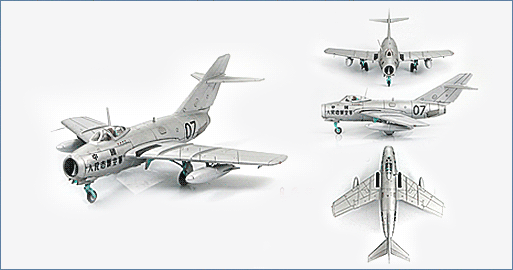Air Power Series>1:72 die-cast display model>MIG-15>HA2409
MIG-15bis Chinese Voluteers's Air Force, 1950s

General Background
The MiG-15 (NATO name Fagot) was designed from information and technology gathered from captured WWII Germans. The main features of the Mig-15 were its simplicity and swept wings. The MiG-15bis was an improved single-seat fighter with better cannon, fuel capacity, avionics and a Klimov turbojet engine developed using an unlicensed Rolls-Royce Nene engine. All this was put in a strengthened airframe. The Allies were completely surprised when the Mig-15 arrived in Korea and quickly brought about the development of the F-86 Sabre.
The Aircraft
North Korea had no jets when it invaded South Korea in June 1950, so
its air force was ultimately destroyed by the American and United
Nations planes, which included first-generation jets like the F-80
Shooting Star. When Communist China sent its troops across the Yalu
River, Chinese MiG-15s went as well, and the second-generation jets
outclassed anything the UN forces had in the air. Only after the
American F-86 Saber arrived could the UN seriously challenge the MiGs.
Specifications :
| Country of origin: | Russia |
| Manufacturer: | Mikoyan-Gurevich |
| Role: | fighter/interceptor |
| Crew: | 1 X pilot |
| Performance | |
| Engine: | 1 X 5,952 pound thrust Klimov VK-1 turbojet |
| Maximum Speed at Sea Level: | 668mph (1,075km/hr) |
| Ceiling: | 50,855ft. |
| Range: | 1,156miles (1860km) |
| Weight | |
| Emptyt: | 8,115lbs. (3,681kg) |
| Max Takeoff: | 13,327lbs. (6,045kg) |
| Dimensions | |
| Wing Span: | 33ft. 0.75in. (10,08m) |
| Length: | 35ft. 7.5in. (10,86m) |
| Height: | 12ft. 1.75in. (3,70m) |
| Armament: | 1 X 37-mm N-37 cannon |
| 2 X 23-mm NS-23 or NR-23 cannon | |
| Up to 1,100 pounds of mixed stores on under-wing hard-points |

